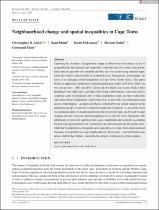JavaScript is disabled for your browser. Some features of this site may not work without it.
- ResearchSpace
- →
- Research Publications/Outputs
- →
- Journal Articles
- →
- View Item
| dc.contributor.author |
Lloyd, CD

|
|
| dc.contributor.author |
Bhatti, S

|
|
| dc.contributor.author |
McLennan, D

|
|
| dc.contributor.author |
Noble, M

|
|
| dc.contributor.author |
Mans, Gerbrand G

|
|
| dc.date.accessioned | 2021-08-25T08:45:12Z | |
| dc.date.available | 2021-08-25T08:45:12Z | |
| dc.date.issued | 2021-06 | |
| dc.identifier.citation | Lloyd, C., Bhatti, S., McLennan, D., Noble, M. & Mans, G.G. 2021. Neighbourhood change and spatial inequalities in Cape Town. <i>Geographical Journal, https://doi.org/10.1111/geoj.12400.</i> http://hdl.handle.net/10204/12098 | en_ZA |
| dc.identifier.issn | 0016-7398 | |
| dc.identifier.issn | 1475-4959 | |
| dc.identifier.uri | https://doi.org/10.1111/geoj.12400 | |
| dc.identifier.uri | http://hdl.handle.net/10204/12098 | |
| dc.description.abstract | Capturing the dynamics of population change in urban areas necessitates access to geographically fine-grained and temporally consistent data for several time points. Such data are generally not available and they must be created using standard population data which cannot usually be compared across time periods. In this paper, the focus is on changing spatial inequalities in Cape Town, South Africa. This paper details an approach to generation of gridded population counts (250m by 250 m) for two Census years – 2001 and 2011. Census data for Small Area Layers (SALs), Spot Building Count (SBC) data, and Open Street Map (OSM) landuse data were used to construct a grid of populated cells to which population counts are then reallocated. The reallocation of population counts from SALs to grid cells was undertaken using area-to-point kriging – an approach which is informed by the spatial variation in the population groups of interest as measured using the variogram. A case study based on population grids of unemployment rates shows how the grids can be used to chart changes and also to measure spatial inequalities across the city at two time points. The advantages of grids for capturing fine-scale complexities and correctly accounting for physical separation between communities is demonstrated and the results show, while the broad patterns of inequality are consistent across time, there are pronounced increases in inequalities in some neighbourhoods. These areas – and what leads some areas to fall further behind – should be the subject of attention by policy makers. | en_US |
| dc.format | Fulltext | en_US |
| dc.language.iso | en | en_US |
| dc.relation.uri | https://pure.qub.ac.uk/en/publications/neighbourhood-change-and-spatial-inequalities-in-cape-town | en_US |
| dc.source | Geographical Journal, https://doi.org/10.1111/geoj.12400 | en_US |
| dc.subject | Census | en_US |
| dc.subject | Grids | en_US |
| dc.subject | Scale | en_US |
| dc.subject | Spatial inequalities | en_US |
| dc.title | Neighbourhood change and spatial inequalities in Cape Town | en_US |
| dc.type | Article | en_US |
| dc.description.pages | 16 | en_US |
| dc.description.note | This is an open access article under the terms of the Creative Commons Attribution License, which permits use, distribution and reproduction in any medium, provided the original work is properly cited | en_US |
| dc.description.cluster | Smart Places | en_US |
| dc.description.impactarea | Urban and Regional Dynamics | en_US |
| dc.identifier.apacitation | Lloyd, C., Bhatti, S., McLennan, D., Noble, M., & Mans, G. G. (2021). Neighbourhood change and spatial inequalities in Cape Town. <i>Geographical Journal, https://doi.org/10.1111/geoj.12400</i>, http://hdl.handle.net/10204/12098 | en_ZA |
| dc.identifier.chicagocitation | Lloyd, CD, S Bhatti, D McLennan, M Noble, and Gerbrand G Mans "Neighbourhood change and spatial inequalities in Cape Town." <i>Geographical Journal, https://doi.org/10.1111/geoj.12400</i> (2021) http://hdl.handle.net/10204/12098 | en_ZA |
| dc.identifier.vancouvercitation | Lloyd C, Bhatti S, McLennan D, Noble M, Mans GG. Neighbourhood change and spatial inequalities in Cape Town. Geographical Journal, https://doi.org/10.1111/geoj.12400. 2021; http://hdl.handle.net/10204/12098. | en_ZA |
| dc.identifier.ris | TY - Article AU - Lloyd, CD AU - Bhatti, S AU - McLennan, D AU - Noble, M AU - Mans, Gerbrand G AB - Capturing the dynamics of population change in urban areas necessitates access to geographically fine-grained and temporally consistent data for several time points. Such data are generally not available and they must be created using standard population data which cannot usually be compared across time periods. In this paper, the focus is on changing spatial inequalities in Cape Town, South Africa. This paper details an approach to generation of gridded population counts (250m by 250 m) for two Census years – 2001 and 2011. Census data for Small Area Layers (SALs), Spot Building Count (SBC) data, and Open Street Map (OSM) landuse data were used to construct a grid of populated cells to which population counts are then reallocated. The reallocation of population counts from SALs to grid cells was undertaken using area-to-point kriging – an approach which is informed by the spatial variation in the population groups of interest as measured using the variogram. A case study based on population grids of unemployment rates shows how the grids can be used to chart changes and also to measure spatial inequalities across the city at two time points. The advantages of grids for capturing fine-scale complexities and correctly accounting for physical separation between communities is demonstrated and the results show, while the broad patterns of inequality are consistent across time, there are pronounced increases in inequalities in some neighbourhoods. These areas – and what leads some areas to fall further behind – should be the subject of attention by policy makers. DA - 2021-06 DB - ResearchSpace DP - CSIR J1 - Geographical Journal, https://doi.org/10.1111/geoj.12400 KW - Census KW - Grids KW - Scale KW - Spatial inequalities LK - https://researchspace.csir.co.za PY - 2021 SM - 0016-7398 SM - 1475-4959 T1 - Neighbourhood change and spatial inequalities in Cape Town TI - Neighbourhood change and spatial inequalities in Cape Town UR - http://hdl.handle.net/10204/12098 ER - | en_ZA |
| dc.identifier.worklist | 24887 | en_US |






